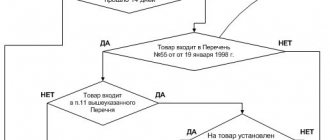Team of lawyers - Yurlidrus writes for you. We tell you our experience, which we have for more than 35 years, which allows us to give the correct answers to everything that may be required in various aspects of life and now we will consider - the Warranty Period of Office Supplies. If, however, to answer your question you need a quick response in your city, then it is better to use a consultant on the site. But it's better to ask in the comments.
Attention, data may quickly become outdated, laws are updated very quickly and are constantly supplemented, so subscribe to us on social networks to keep abreast of all updates to the material.
If the technical documents for the supply of machinery and equipment contain warranty requirements, then the customer is obliged to specify in the procurement documentation its duration, quality scope, requirements for service, maintenance costs, installation and commissioning of equipment for the entire warranty period. If you are choosing a supplier of new machinery and equipment, include in the documentation the requirements for the manufacturer's or supplier's warranty, as well as its validity period. Documents are transferred and filled out along with the goods.
The concept of product warranty period
The warranty period is the period during which the consumer, upon detection of any shortcomings and defects in the purchased product, can present to the seller (manufacturer, authorized organization or individual entrepreneur, importer) demands regarding the quality of the product (return, replacement, free elimination of the defect , price reduction, etc.), and they are obliged to satisfy the legal requirements of the consumer (clause 6 of Article 5 of the Law on the Protection of Consumer Rights).
The warranty period is established for durable non-food products. For food products, as well as non-durable and disposable goods, such as cosmetics, perfumes, sanitary and hygiene items, medicines, dietary supplements, household chemicals, the manufacturer must set an expiration date.
Warranty periods vary depending on the nature of the product. For example, for cars and other transport these periods are set from two years, for household appliances from six months, for clothes and shoes from one to several months or a year. If we are talking about a shared construction project, then a special law on shared construction obliges the developer to establish a warranty period for such an object for at least 5 years.
It is necessary to take into account the operating conditions and the owner’s compliance with the rules of use, storage or transportation of the goods, i.e. actions of the consumer themselves can lead to premature wear and damage to the product.
Article 476 of the Civil Code of the Russian Federation and paragraph 6 of Article 18 of the Law on the Protection of Consumer Rights directly stipulate that the seller is responsible for defects in the goods identified during the warranty period only if he does not prove that the defects arose precisely through the fault of the consumer himself after the goods were transferred to him , i.e. for reasons beyond the control of the seller or manufacturer.
We are talking about those cases when a thing fails completely or partially with proper and correct use.
It happens that you buy new boots or a coat, and a month later you discover a tear in the fabric, a peeling sole, characteristic stains in the color of the product, a broken zipper, or a hole in a leaky place on the fabric, or a recently purchased household appliance or expensive gadget suddenly breaks down. In such cases, one can raise the question of inadequate quality of the product; we can also talk about a manufacturing defect of the product.
Consumer rights lawyer in St. Petersburg. Tel.+7 (812) 989-47-47 Telephone consultation
Refund
Another consumer right in the event of purchasing a product of inadequate quality is the right to demand a refund for the defective product.
This requirement must be made in writing on a claim form.
Contents of the claim
Here's what you should include in your claim:
- personal data (full name, phone number, email);
- store address, its name;
- date of purchase;
- name of the product (brand, model, serial number, etc.);
- payment method (cash or credit card);
- a detailed description of the detected deficiencies and under what circumstances they were discovered);
- payment documents (payment receipt (if available), statement from your bank account);
- demand for the return of a sum of money;
- if the purchase was purchased by non-cash payment, indicate the bank account number to which the money for the goods should be returned, full name and full name.
The claim is drawn up in 2 copies, one of which is handed over to the seller, the other copy remains with the buyer, on which it is mandatory to require the seller to put a mark of acceptance, indicating the date, as well as the position of the person who accepted the claim. This is an extremely important step that buyers often overlook.
However, if for some reason the consumer does not have a sales receipt, this is not a reason for the seller to refuse to satisfy his demands (Clause 5 of Article 18 of the Law on the Protection of Consumer Rights).
Return deadlines
The law establishes a 10-day period for returning money for goods from the date of presentation of the demand.
Refusal to return
In the event that the seller refuses to return the money and offers the buyer to make repairs, but the buyer does not want this, it is necessary to clearly understand that such behavior of the seller is illegal.
In your application for a refund, you can separately state that the buyer does not agree to repairs, but insists solely on a refund. And here it does not matter whether the seller voiced an offer for repairs or not.
If the seller refuses to accept a claim from the buyer, do not be upset. Sending a claim by registered mail with notification is also considered as proper compliance with the mandatory pre-trial dispute resolution procedure.
Refusal to return money for goods can only be justified in the following cases:
- the defects were caused by the buyer;
- expiration date has expired
Who sets the warranty period for a product?
According to Article 5 of the Law on the Protection of Consumer Rights, the warranty period for a product can be established:
- Manufacturer
- By the seller (if the warranty period is not established by the manufacturer)
As we see, first of all, the manufacturer has the right to establish a warranty on a product, while the seller acquires such a right only in the absence of a factory warranty.
Thus, the law excludes the possibility of establishing two guarantees for the same product.
For information about in what cases requirements regarding poor quality of goods are presented to the manufacturer, seller or importer, and in what cases the consumer is provided with an alternative, read the article return of low-quality goods.
From what date is the product warranty period calculated?
The procedure for calculating warranty periods is set out in Article 19 of the Law on the Protection of Consumer Rights.
The warranty period for the product begins to expire:
- If the agreement between the seller and the consumer does not establish special dates for the start of the warranty period of the goods - from the moment the goods are transferred to the consumer.
- If the day of purchase of the goods is unknown - from the moment of manufacture of the goods
- For seasonal goods - from the beginning of the corresponding season, and if the product was purchased during the season - from the moment of transfer (delivery - in the case of remote purchase) to the consumer (read more about this below)
- When selling goods by samples or by mail - from the moment the goods are delivered
- If the day of sale and the day of delivery of the goods do not coincide - from the moment of delivery of the goods
- If it is impossible to establish the date of delivery, installation, assembly, connection of the goods - from the moment of concluding the purchase and sale agreement (day of purchase)
- If special installation (connection, assembly) of the product is required, or if the product has defects, the warranty period is suspended until the seller eliminates the specific circumstances
The warranty period for technically complex goods, as well as for goods purchased on sale, is calculated according to general rules.
Warranty obligations on the part of the supplier for office paper according to the legislation of the Russian Federation
proof certificate know. In this regard, Article 18 of the Law of the Russian Federation “On the Protection of Consumer Rights” (hereinafter referred to as the Law) states that if during the purchase and sale procedure there is no problem of inadequate quality (the seller does not report the presence of possible defects), then the buyer is given the following options:
Product warranty period 2020
From what day is the warranty period and service life of the product calculated? The warranty period of the product, as well as its service life, are calculated from the date of sale of the product to the consumer (unless otherwise provided by the contract). If the day of sale of the goods cannot be determined, these periods are calculated from the date of manufacture of the goods (Clause 2 of Article 19 of the Law of the Russian Federation “On the Protection of Consumer Rights”).
- free repairs or compensation for the cost of independent restoration work (in this case, you must provide a receipt for the elimination of defects as evidence);
- proportional reduction in cost, i.e. carrying out markdowns of goods in accordance with detected defects and defects;
- exchange for a product of the same model or similar with similar functions of another brand, taking into account the difference in price;
- termination of the purchase and sale agreement.
Warranty period for seasonal goods
When purchasing a seasonal product, i.e. of a product intended for use and operation in a certain season of the year, the warranty period begins to run not at the time of purchase of this item, but from the moment the corresponding season begins after purchase. If a product is purchased based on samples, or purchased remotely and received by mail, or delivered by courier, then the warranty period should be calculated from the moment the buyer receives the product.
If the product is purchased after the start of the season for which it is intended, then the warranty for it begins to run from the moment of purchase or delivery.
So, for seasonal goods, the warranty period begins:
- As a general rule - with the onset of the corresponding season
- When purchasing goods after the onset of the corresponding season - from the moment the goods are transferred
- When purchasing goods remotely (by mail or by samples) - from the onset of the corresponding season
- When purchasing goods remotely (by mail or by samples) after the onset of the corresponding season - from the moment of delivery of the goods
There is no officially approved list of seasonal goods in our country, but Article 19 of the Law on the Protection of Consumer Rights stipulates: clothing, shoes, etc., so most often we are talking about winter, demi-season, summer shoes or outerwear. We believe that this also includes, for example, alpine skiing and other winter sports equipment, the use of which in our country is possible only during the winter season.
In any case, to determine the seasonality of a product, one should proceed from the purpose of the product, from information about it, take into account its characteristics and operating rules in general.
Each subject sets its own start dates for the seasons, which is explained by different climatic conditions in different parts of the country, and they are determined by the local legislation of each subject of the Russian Federation.
The following dates for the onset of seasons have been established for St. Petersburg (Law of St. Petersburg dated May 28, 1997):
- Winter season – from December 5
- Spring season – from March 17
- Summer season – from June 2
- Autumn season – from September 12
Consultation with a lawyer on consumer rights. Tel.+7 Telephone consultation
Product without warranty period
Let us remind you that the consumer can return the goods during the warranty period. However, establishing a warranty period for a product is not the responsibility of the manufacturer or seller , but their right. Don’t be surprised if, after purchasing something, you discover that there is no warranty period. This does not mean that if a defect is detected, such a product cannot be returned.
The requirements established by Article 18 of the Law on the Protection of Consumer Rights regarding the quality of a product for which a warranty period is not established can be presented if :
- Defects in the goods were discovered within a reasonable time, but within two years from the date of delivery of the goods
- The consumer will prove the occurrence of the defect before the goods were sold to him, or for reasons that arose before that moment (in the event of a dispute about the nature of the defect)
It is best to contact the seller (manufacturer) immediately upon discovering a defect in the product, without waiting for a two-year period, and completely exclude further use of the item, since in the event of a trial, it is possible to conduct an expert examination of the product in order to establish the causes of the defect. Therefore, it is in the consumer’s interest to report a defect immediately after its discovery, this will allow the nature of the defect to be most accurately determined. The court can determine the reasonableness of the period for identifying a defect if the dispute is not resolved pre-trial, based on the features and characteristics of the goods, as well as the terms usually established for similar goods.
How does the seller calculate income tax when the buyer returns a defective product?
A citizen, when purchasing products of inadequate quality, has the right to demand a refund of the entire amount paid, abandoning the contract completely, or to replace the damaged product with a quality one. P 3, Article 477 of the Civil Code of the Russian Federation establishes that requirements for the quality of goods that have a guarantee can be presented during the warranty period. If a warranty is not provided, then the period for submitting claims does not exceed two years from the date of purchase. It must be taken into account that the buyer’s demands for replacement of goods or refund of money will be considered fair only if there is a significant violation of its quality. Essential deficiencies are those that cannot be eliminated, or those that require disproportionate expenses to eliminate. In tax accounting maintained by the seller, the operation to return defective goods is reflected in one of the following ways:
- the tax base for income tax is recalculated for the period in which the defective product was sold;
- costs in the form of the cost of returned defects are included in expenses in the form of losses from defects (clause 47, paragraph 1, article 264 of the Tax Code of the Russian Federation).
Let us explain why the seller can use recalculation of the tax base. If the buyer returns a defective product, the contract is terminated. This means that the taxpayer (seller) did not receive income from the sale of this product. And he can reduce his income for this period by the amount of proceeds from the sale of such a product, and, accordingly, reduce the amount of expenses by its cost. It is important to take into account that if the taxpayer does not fully reflect information about income in the declaration, or if errors are detected, it is necessary to make additions and changes to it (updated income tax declaration). This is the responsibility of the tax payer. If the report contains distortions relating to periods that have already passed, this leads to the need to provide updated tax returns for precisely those periods where there were errors. You can attribute the costs of the cost of a low-quality product to losses from defects, and justify this as follows: justified and documented costs are subject to tax if they are made to make a profit. Among the taxable expenses (clause 1 of Article 264 of the Tax Code of the Russian Federation) aimed at the production and sale of products, there is an expense column that provides for losses from defects. The Tax Code of the Russian Federation does not define the concept of “marriage”, therefore the definition contained in the regulations on accounting is used. And then marriage is divided into two types:
- internal (losses from it are identified during production or sale);
- external (was noticed by the consumer already during assembly, installation or use of the product).
Therefore, when the buyer returns the goods, having discovered defects within the legal period (Article 477 of the Civil Code of the Russian Federation), the seller, when taxing, can take into account the cost of the returned item as expenses from losses in the form of external defects. This expense is confirmed by documents. And since the cost of the defective item was taken into account as a sales expense, when returned, its price is recognized as zero. Therefore, if this product is subsequently sold again or used in any way, then it is not included in the list of expenses again, which means it is not subject to tax. Thus, the income tax of an organization when a buyer returns a defective product is calculated in one of the two ways discussed above.
The product warranty period has expired
The expiration of the warranty period of a product does not always exclude the possibility of its return or exchange if defects are found in it outside the warranty period.
According to paragraph 5 of Article 19 of the Law on the Protection of Consumer Rights, the consumer has the right to present a claim to the seller or manufacturer regarding the quality of the product if:
- The warranty period for the product is less than 2 (two) years
- The defect was discovered after the expiration of the warranty period, but within 2 (two) years
- The consumer will prove that the identified defect arose before the seller transferred the goods to him, or for reasons that arose before the sale of the goods to him (in the event of a dispute about the nature of the defect)
Let's give an example: the warranty on the phone is 1 year; during the first year, warranty repairs were carried out, but during the second year of operation, the defect appeared in the phone again. In this case, despite the expiration of the warranty period, the consumer will have the right to make a claim to the seller for the return, replacement or repair of the phone, only on the condition that the consumer provides evidence that the identified defect is of a hidden manufacturing nature, i.e. arose before the transfer to him, or for reasons that arose before the sale of the goods. Such evidence will be an independent expert opinion confirming this fact. The examination is carried out at the expense of the consumer, and if it confirms the manufacturing nature of the defect, you can present to the seller (manufacturer) one of the requirements provided for in Article 18 of the Law on the Protection of Consumer Rights, attaching an expert opinion to the claim, and you can demand reimbursement of the costs of the examination.
In addition, the manufacturer or seller may voluntarily assume additional obligations with respect to product defects discovered outside the manufacturer's warranty period.
The conditions, terms and procedure for fulfilling the additional obligation are established by the manufacturer himself. When such an obligation is accepted by the seller, all conditions are specified in the agreement (contract) between the seller and the consumer.
If additional obligations of the manufacturer or seller exist, but a dispute has arisen between the parties regarding the nature of the defect, the following nuances of distribution of the burden of proof of the nature of the identified defect must be taken into account:
- If defects in the goods are discovered during the period of the additional obligation of the manufacturer or seller, the burden of proving the nature of the defect lies with the manufacturer or seller.
- If after the expiration of the additional warranty, but within two years after the transfer of the goods to the consumer, then the burden of proving the occurrence of defects in the goods before its transfer to the consumer or for reasons that arose before this moment falls on the consumer himself.
Lawyer's answers to private questions
Is it possible to return a product if the warranty period has expired?
If the warranty period for the product has expired, and after that some defect in the product (defect) has already been discovered, and this defect is of a manufacturing nature, the consumer has the right to make claims to the seller regarding the quality of the product within 2 years from the date of purchase.
What is a significant disadvantage of the product?
A significant defect in a product is an irreparable defect or defect that cannot be eliminated without disproportionate expenditure of time, or is detected repeatedly, or appears again after its elimination, and other similar defects.
Where is the product warranty period indicated?
As a rule, the warranty period is specified in the purchase and sale agreement, or in the warranty card.
Warranty for components and components of the product
The manufacturer may establish a warranty period separately for components or components of the main product (clause 3 of Article 19 of the Law on the Protection of Consumer Rights). The warranty period for them is calculated in accordance with the general procedure.
Therefore, a return or exchange of component parts of a product is possible regardless of the quality of the main product .
There are the following features of the warranty period for components and components of the main product:
- If the warranty period for a component product or component is set to be shorter than for the main product, the consumer has the right to make a claim regarding the quality of such product or part of the product during the warranty period for the main product.
- If the warranty for a component product or component of a product is greater than the warranty for the main product, the consumer may make a claim regarding the quality of the product provided that defects in the component product are discovered during the warranty period for this product, regardless of the expiration of the warranty period for the main product.
Arbitrage practice
- The plaintiff judicially terminated the purchase and sale agreement and returned the money for the goods, according to the warranty period - judicial practice No. 1.
- Dispute regarding the warranty period for components (car engine turbine). The court recognized the requirements for extending the warranty period to component products as justified, and recovered the cost of repairs from the seller - judicial practice No. 2.
- A dispute regarding the elimination of defects in a product after the expiration of the warranty period, but within 2 years. The court found the claims to be justified – judicial practice No. 3.
What additional information do you need to know about the product warranty period?
- The warranty period of the product is extended for the period of warranty repair (clause 3 of Article 20 of the Law on the Protection of Consumer Rights)
- When replacing a product, the warranty period begins again, i.e. from the moment of replacement (clause 2 of Article 21 of the Law on Protection of Consumer Rights)
- When replacing a component or component of a product, the warranty for the new product or component begins again, i.e. from the moment the goods are returned from repair (clause 4 of Article 20 of the Law on the Protection of Consumer Rights)
- The warranty period is calculated in units of time: years, months, days; and other units of measurement, depending on the functions and purpose of the product: kilometers, meters, etc. (clause 3 of Article 5 of the Law on the Protection of Consumer Rights)
- Information about the warranty period for the product is indicated in the warranty card, in the receipt or in the sales contract. The manufacturer's warranty is usually stated in the technical documentation for the product.
Consumer rights lawyer. Tel.+7 Telephone consultation
Costs of warranty repairs for tax accounting purposes
In accordance with paragraph 9 of paragraph 1 of Article 264 of the Tax Code of the Russian Federation, other expenses associated with production and sales include the taxpayer’s expenses for the provision of warranty repair and maintenance services, including deductions to the reserve for future expenses for warranty repairs and warranty service (taking into account the provisions of Article 267 of the Tax Code of the Russian Federation).
Warranty repairs are recognized as repairs carried out by taxpayers during the warranty period.
Warranty service consists of the provision of technical and other maintenance services during the warranty period.
Accordingly, contracting companies (manufacturers, sellers) have the right to take into account the following expenses for profit tax purposes:
- for warranty repairs,
- warranty service,
carried out within the framework of concluded contracts during the established warranty period.
At the same time, such expenses must comply with the requirements of Article 252 of the Tax Code of the Russian Federation, i.e. economically justified and documented.
In order to evenly include costs for warranty repairs and maintenance in expenses, companies have the right to create a reserve for warranty repairs in tax accounting, providing for the procedure for its creation in the accounting policy for tax accounting purposes.
Product expiration date. Product service life and warranty period
When purchasing a food or non-food product, most buyers always check the expiration date or service life of the product.
What you need to know about the expiration date:
- The expiration date is mandatory set by the manufacturer (performer) for food, cosmetics, perfumes, medicines, household chemicals, hygiene items, dietary supplements and other similar products.
- If there is no expiration date, or after the expiration of this period, such goods are prohibited for sale, since they can pose a serious danger to the life and health of the consumer.
- The consumer has the right to file a claim with the seller (manufacturer) during the shelf life of the product
What are the features of the product service life:
- The service life is set by the manufacturer for durable goods, at will. During the service life, the manufacturer undertakes to ensure that the product is suitable for its intended use, i.e. the product must serve while maintaining the qualities declared by the manufacturer, and in the event of significant defects in the product, the manufacturer must bear responsibility for them as provided for by law.
- For durable goods and their components, which after a certain period may become dangerous to the life and health of the consumer, as well as to the environment, or cause damage to the consumer’s property, the manufacturer is obliged to establish a service life so that the requirements for product safety can be met, i.e. e. the consumer must be informed for what period of time such a product is safe to use. The list of such goods was approved by Decree of the Government of the Russian Federation dated June 16, 1997 No. 720 (as amended on May 10, 2001).
Consumer rights when a significant defect in a product is discovered during the service life of the product:
- If during the service life of the product, even after two years after the delivery of the product to the consumer (or within 10 years if the service life is not established), a significant defect is discovered in it, the consumer has the right to present to the manufacturer or authorized organization or importer a demand for free repair .
- The only condition for presenting the above requirement is that the consumer must prove that a significant defect arose before the goods were transferred to him or for reasons that arose before that, i.e. production or hidden nature of the deficiency.
- The manufacturer is obliged to satisfy the requirement to eliminate a significant defect in the product free of charge within 20 (twenty) days from the date of filing the claim.
- If the consumer's request for gratuitous elimination of the defect within 20 days is not satisfied, the consumer has the right to demand replacement or return of the product, or make other demands provided for in Article 18 of the Law on the Protection of Consumer Rights.
- If an examination of a product establishes that a defect identified during its service life (or within 10 years in the absence of a service life of the product) is irreparable, the consumer has the right to immediately demand that the manufacturer or importer exchange or return such goods (clause 6 of Article 19 of the Law on protection of consumer rights), bypassing the stage of free elimination of product defects.
Repair under warranty
The consumer rights protection law establishes the consumer's right to warranty repairs as an additional obligation of the seller. Accordingly, repairs that can be carried out during the warranty period will be called warranty repairs.
Application procedure
If after purchase any defects were discovered, or the product failed through no fault of the consumer, in this case you need to contact the store where the product was purchased and write an application for warranty repair.
Such a statement can be drawn up in any form, but it should indicate:
- Date of purchase;
- Information about the buyer (full name, phone number, etc.);
- Address of the store where the product was purchased;
- Data about the product being delivered (model, brand, serial number, etc.);
- Product warranty period;
- Describe in detail the circumstances under which the defect was discovered;
- The purpose of delivery of goods is repair or quality control;
- Date and time of delivery of the goods.
So that in the future the consumer can document the fact of handing over the goods for repair, it is advisable to insist that a transfer and acceptance certificate be drawn up in 2 copies. The act must indicate:
- Date of purchase;
- Who purchased the goods (full name of the buyer)
- Product defects;
- What comes with the product;
- Condition of the goods at the time of receipt (all visible damage (chips, cracks);
- Sometimes you may need payment documents or checks (in this case, you should make copies of the checks for yourself and keep them).
The certificate should be kept until the repair is completed and the item is returned.
Unfortunately, there are common cases when a store seller refuses to accept a product under warranty, citing the fact that you should contact the manufacturer’s service center for free repairs. This behavior of the store is illegal, since the buyer retains the right to choose who to contact for repairs. The presence of a sales receipt is a circumstance that obliges the seller to fulfill the warranty obligations assumed.
Product examination
In some cases, it may be necessary to conduct an examination of the goods. This may occur when the seller suspects that the breakdown was the fault of the buyer. The period for conducting the examination should not exceed 20 days.
The consumer is also not deprived of the right to conduct his own independent examination, so that if the store refuses to carry out repairs at his own expense, he can prove in court the fact that the defects of the product were not his fault and this case is covered under warranty. In this case, the independent expert’s opinion will be written proof of his innocence.
The seller will also be required to reimburse the buyer's expenses for conducting an independent examination.
Warranty repair period
The law does not require a written deadline for repairing the product. This remains at the discretion of the parties (seller and buyer). However, if such a period was not specified, and the consumer nevertheless asked a question regarding the defects of the product, then these defects must be eliminated immediately, that is, within the minimum period that is objectively required for their elimination, subject to repair in the usual way.
If the parties decide to prescribe a period for repairs, then the maximum period cannot exceed 45 days. Here the question may arise: what days are we talking about - calendar days or working days?
According to the general rule established by law, if there is no indication of working days, they will be calculated in calendar days.
Consumer rights when returning goods for repair under warranty
If the repair period lasts longer than the established period, the consumer has the right:
- demand payment of a penalty, which is 1% of the price of the goods, for each day of delay;
- replace the product with a similar one during the repair period;
- refuse the goods and demand a refund.
When handing over a durable product for repair, the consumer has the right to demand that a similar product be provided in return. The seller is obliged to fulfill such a requirement by virtue of the direct instructions of the law (Clause 2 of Article 20 of the Law on the Protection of Consumer Rights).
This requirement can be rejected by the seller only if it concerns a product that cannot be replaced with a similar product during the repair period. The list of such goods was approved by Government Decree No. 2463 dated December 31, 2020. This list includes: cars, motorcycles, electrical appliances (microwave, electric razor, hair dryer, etc.), furniture, civilian weapons, jewelry.
Warranty period after repair
The warranty period after repair is extended for the period during which the product was not used and was under repair.
This period is calculated from the day the consumer applied for repairs until the day of issue after repairs.
After the repair, at the time of issue, the consumer is given documents that must contain the following information:
- date of application for repair;
- date of delivery of the goods for repair;
- date of repair, with a detailed description of the defects of the product eliminated;
- whether any spare parts or components were replaced;
- date of delivery of the repaired product to the consumer.







